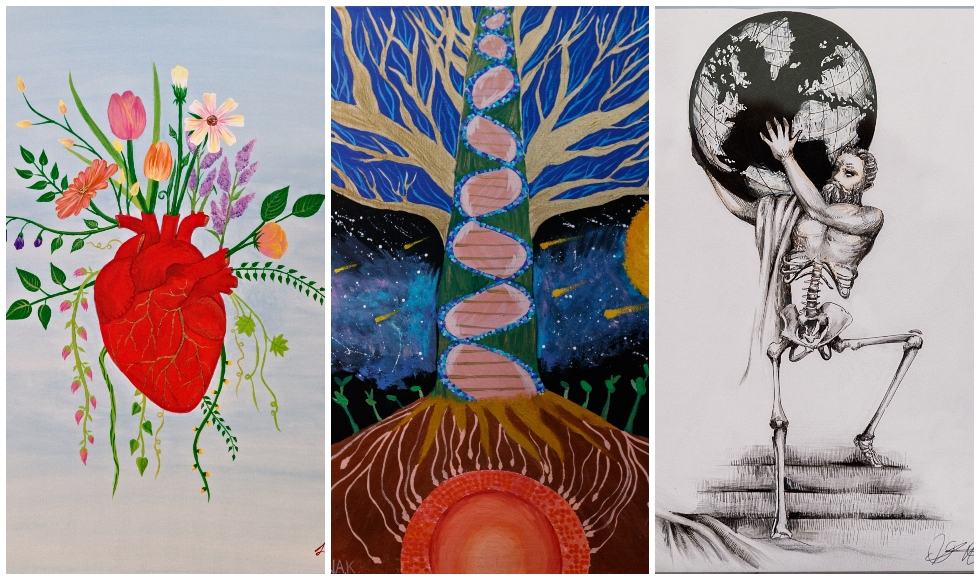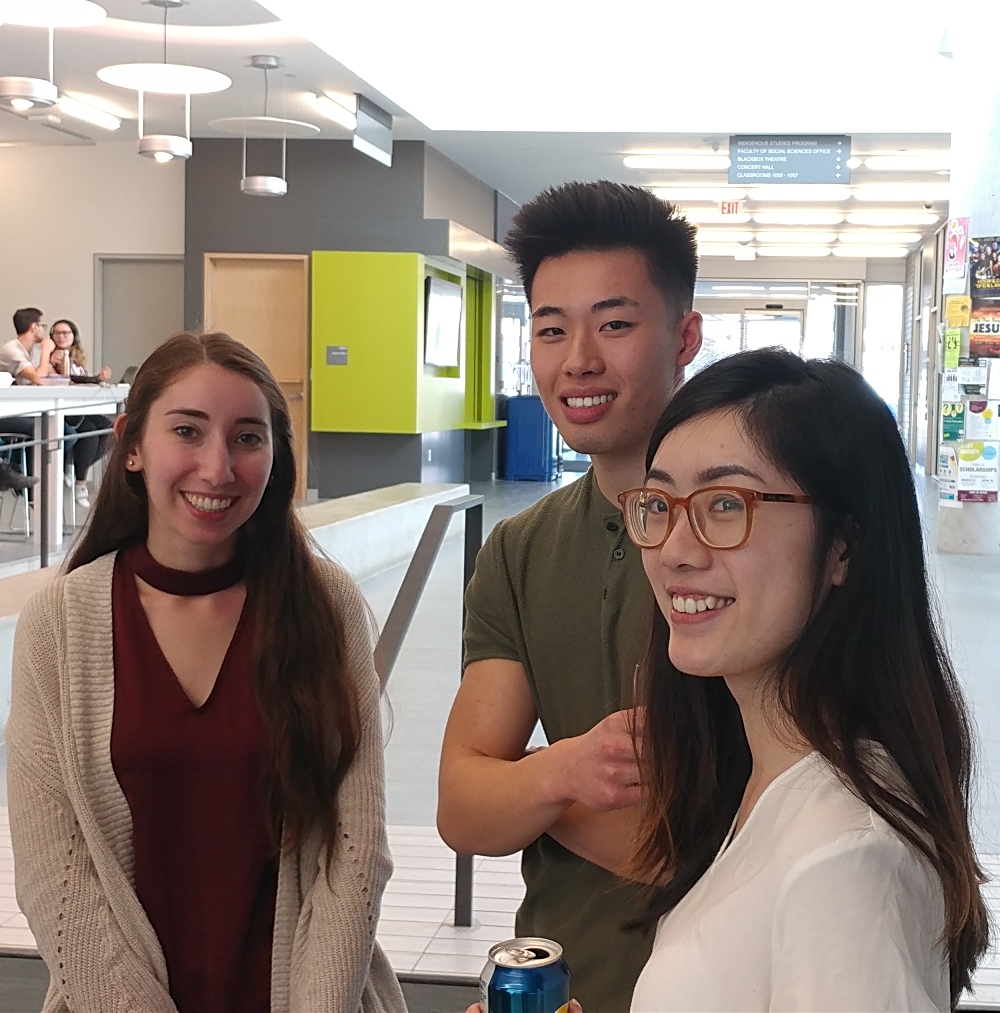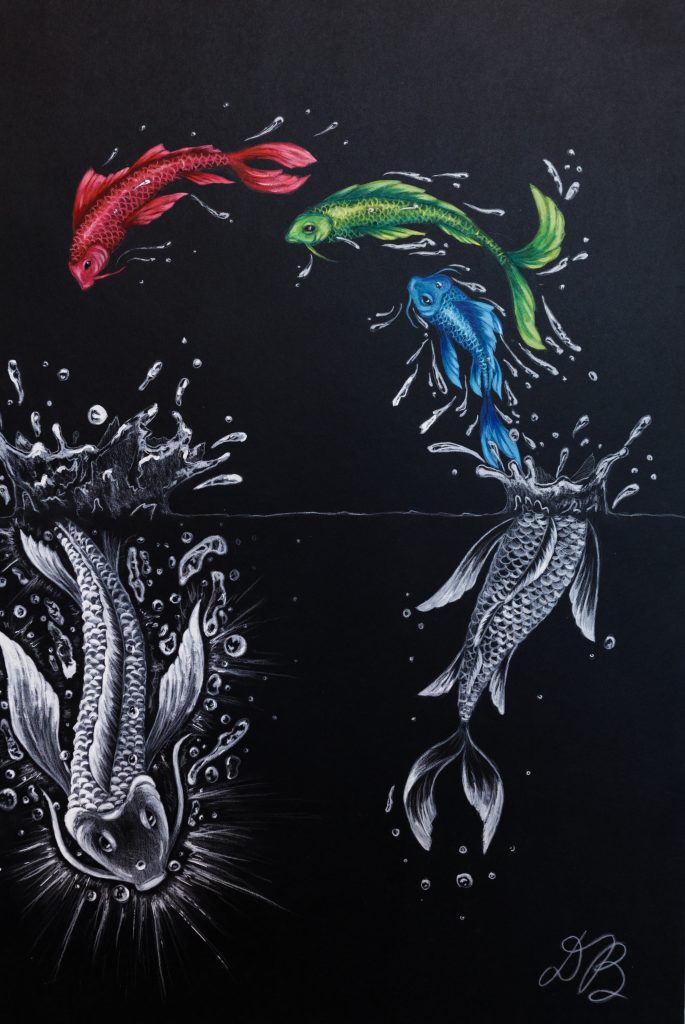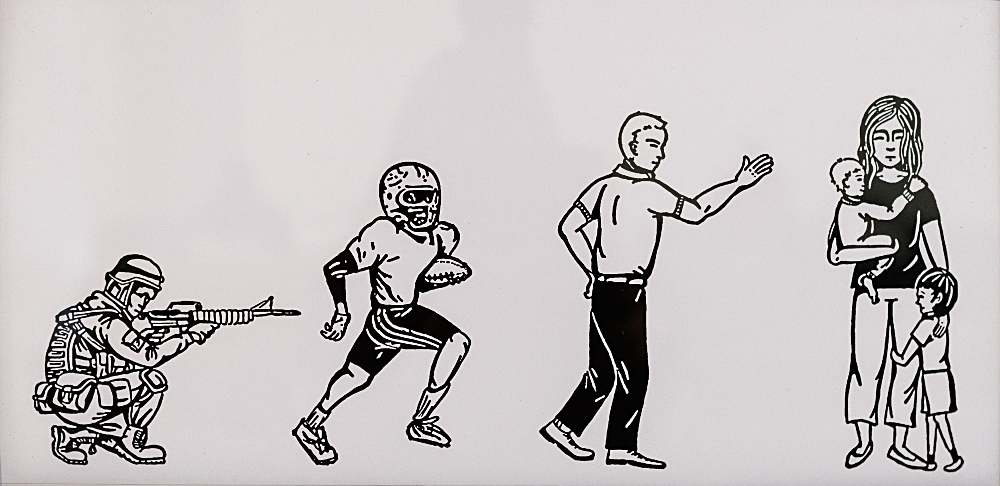New student-led exhibition explores the intersection of science and art

(From left) ‘Floral Atrium,’ Acrylic on Canvas, by Labiqah Iftikhar, Honours Biology; ‘Beginning of Life,’ Acrylic on Canvas by Anchana Kuganesan, Honours Life Sciences; ‘Strength in Bones, ‘Marker & Pen on Paper by Snow Wangding, Honours Biochemistry. This artwork is among the many pieces that will be on display in until March 29 in the Waller Family Lobby in L.R. Wilson Hall.
From the mysteries of deep ocean ecosystems, to the evolution of brain injury research, to the origins of life on Earth, a new exhibit is exploring and communicating complex science in an unconventional way – through the power of art.
Visualizing Science– presented by the Faculty of Science and the Socrates Project, is a unique, student-led exhibition featuring artworks created by students and staff from across McMaster, all inspired by science.

“There are a lot of scientists out there who are also artists,” says Shira Weiss, a fifth year Life Sciences Co-op student who organized the exhibit with Jason Tran, a student in the Biomedical Discovery and Commercialization program, and Debbie Kao, a fourth-year health sciences student. “This exhibition is a way to provide a platform for students and others to express that side of themselves and bring art and science together.”
Visualizing Science features 20 artists from diverse disciplines including science, engineering, health sciences, commerce and humanities. Their art was created using a range of mediums – from ink and paint, to fibre art, digital art and even video.
The exhibition, now it its fourth year, was co-founded by Weiss and Susie Son, a Biochemistry and Biomedical Sciences student who has since graduated, with support from Kim Dej, associate vice-provost (Faculty) and a faculty member in the School of Interdisciplinary Science.
“The idea was to support students who really enjoy thinking and talking about science, but who wanted to represent science in a different way,” says Dej “So many students love science and they can see a career goal in mind, but they are also talented artists and they want to pull together those two interests – this is a great opportunity to encourage that kind of passion.”
Visualizing Science will be on display until March 29 in the Waller Family Lobby in L.R. Wilson Hall.
View selected pieces from this exhibit:

FinLand, Ink on paper by Steven Kenny, Commerce
Humans know more about the surface of the moon than the bottom of the ocean. But considering all the bizarre organisms we have discovered, one can’t help but wonder what else goes on down there that has yet to be revealed.

Warm Little Pond, Fibre Art Mixed Media by Jacqueline Langille, Faculty of Humanities
Inspired by the work of McMaster University professors Ralph Pudritz, Yingfu Li, and others at the Origins Institute, my fibre art represents the concept of the “warm little pond,” first described by Charles Darwin in a letter [1871]. Scientists working to determine how life began on planets such as Earth billions of years ago resonates with the Visualizing Science “new beginnings” theme. My piece uses whimsy and 3D elements, with a quilted textile background, to represent the nucleobases and RNA that mixed (theoretically) in the warm little pond to generate life forms.
Video by Sujane Kandasamy (Health Research Methodology) and Bhavna Samtani (Life Sciences alumna )in collaboration with spoken word artist Tahnee Wilson.
This film is a four-minute poem written and performed by Six Nations spoken word artist Tahnee Wilson, with accompanying visuals directed by Sujane Kandasamy and Bhavna Samtani and filmed and produced by Bhavna Samtani. The poem was crafted in collaboration between Wilson and Kandasamy, and creatively portrays the findings from Kandsamy’s MSc thesis (Perinatal Wellbeing in an Aboriginal context, submitted to the School of Graduate Studies, McMaster University). We decided to translate the findings of this research in this way because of the cultural meaning of stories and importance of the oral tradition for the Six Nations community. The poem brings the knowledge together in a way which is similar to the oral transfer of knowledge within Indigenous cultures and the visual scenes in the video were chosen to reiterate the poignant message of the poem in a way that has meaning and resonance with the target population: Indigenous women of reproductive age.

Transience, Acrylic on Canvas by Daria Vorobyova, Kinesiology
Our lives are very much governed by classical mechanics; however, there comes a time where we must transgress from these principles and step into the realm of the quantum. In 2018, the Nobel Prize is Physics was awarded to three individuals, two of whom worked on inventing high-intensity ultrashort pulses of light which can produce precise cuts to be used in medicine (e.g. laser eye surgery) and many other fields. Their innovative method solved the dilemma of the inability to amplify an already strong light pulse. By breaking down the orignal incoming pulse into its smaller wavelength components (red, green and blue light), then amplifying said components and finally putting them back together, this resulted in a very strong amplified outgoing pulse. Fun fact: one of the Nobel winners was Donna Strickland, a McMaster EngPhys graduate!

The Evolution of Brain Injury Research, Digital Art by Noel Kim, Integrated Science
Intimate Partner Violence (IPV) affects more than just the body and mind; it affects the brain. The Turkstra lab is researching brain injury in women who are victims of IPV. Previously, researchers and the media focused primarily on brain injury in men: military personnel, athletes, and perpetrators of IPV. Recently, we have begun to investigate how brain injury uniquely affects women who are victims of IPV and may affect their ability to leave violent relationships. This beginning in research is paving the way for women to receive rehabilitation and create their own beginnings away from violence.


